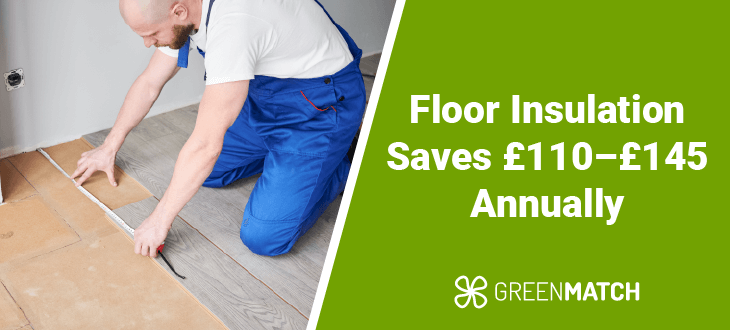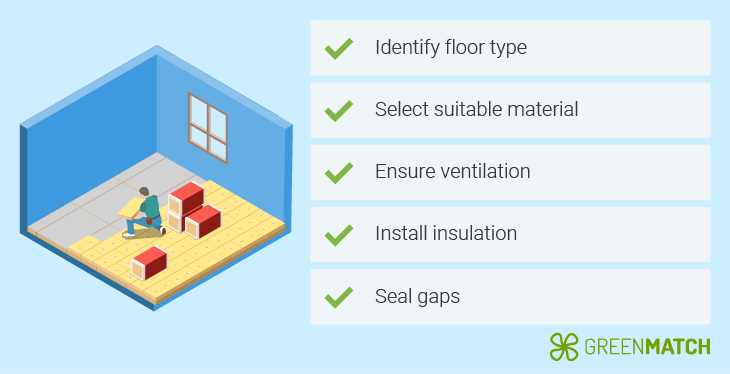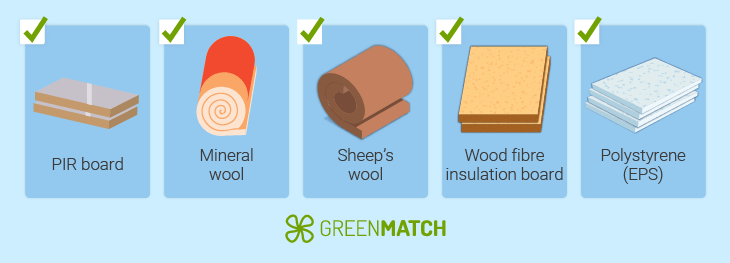Answer these simple questions and we will find you the BEST prices
Which type of solar quotes do you need?
It only takes 30 seconds
100% free with no obligation

Get Free quotes from insulation specialists near you

Save money by comparing quotes and choosing the most competitive offer

The service is 100% free and with no obligation
- GreenMatch
- Insulation
- Floor Insulation
- Underfloor Insulation for Wooden Floors
Underfloor Insulation for Wooden Floors: A Complete Guide (2025)


- Underfloor insulation for wooden floors involves placing insulation beneath the floorboards to reduce heat loss and improve energy efficiency.
- A detached home can save up to £110 annually in Great Britain and £145 annually in Northern Ireland through floor insulation.
- The cost of insulating a wooden floor will vary depending on the material used, ranging from £5 to £24 per m². For a 35m² project, expect to pay between £175 to £840 for materials alone.
According to the UK’s Department for Business, Energy & Industrial Strategy, uninsulated floors account for 10-20% of a home’s heat loss. This contributes to higher energy bills, a larger carbon footprint, and reduced comfort. Adding underfloor insulation offers a valuable upgrade, enhancing thermal comfort, lowering energy costs, and reducing carbon emissions with a single investment.
This guide provides everything you need to know about underfloor insulation for wooden floors in the UK, including the costs, process, types of insulation materials, and advantages you could enjoy.
Ready to insulate your floor? Look only as far as GreenMatch UK for a one-stop solution to all your needs. Instead of spending hours online, fill out our 30-second form to receive up to 3 free quotes from trusted experts and take the first step toward a warmer, more efficient home today! Click below to begin.
- Describe your needs
- Get free quotes
- Choose the best offer
It only takes 30 seconds



How to insulate wooden floors?

Insulating wooden floors can help reduce energy bills, keep your home warmer, and minimise heat loss. While hiring accredited professionals is recommended for the best results, you can tackle suspended timber floor insulation as a DIY project.
Here’s a step-by-step guide to help you do it effectively!
- Identify your floor type: First, determine if your floor is suspended timber, common in many older homes. This type of floor has a gap or crawl space underneath. You can also identify suspended timber floors by checking the ceiling of the floor below for floor joists. Joists are horizontal wooden beams that your floorboards rest on. If your home has this setup, this insulation method suits you.
- Choose the right material: When insulating a wooden floor, choosing the best material for your needs is essential. PIR boards, like Kingspan, are highly efficient and offer an impressive thermal performance, but they come at a higher cost. Mineral wool is cheaper but requires at least 150mm of thickness to achieve the same insulation effect. Alternatively, natural options such as wool or hemp are ideal for older homes as they are eco-friendly and allow the floor to breathe, helping manage moisture.
- Ensure proper ventilation: Ensure sufficient ventilation under the floor before installing the insulation. This includes leaving a 50mm air gap between the insulation material and floorboards. Good airflow is crucial to preventing moisture build-up and keeping the timber dry. This helps maintain the longevity of the insulation and the floor itself.
- Install the insulation: There are two ways to install insulation depending on whether you have access to the floor from below or above. If you access the floor from below, fit floor board insulation (such as PIR boards or mineral wool) tightly between the joists and secure it with battens or netting. If you access the floor from above, remove the floorboards, place floor joist insulation (between the joists), and then add a vapour control layer to keep it airtight and dry.
- Seal the gaps: After installing the insulation, seal any remaining gaps around the edges of the floor with airtight tape or membranes. These can be purchased at your local hardware store. This step is essential to prevent draughts and ensure the insulation works efficiently.
While the DIY process may seem straightforward, a poor DIY job can quickly become a financial nightmare rather than a great home upgrade. For this reason, it is highly recommended that you work with a professional installer.
Wooden floor insulation types

Now that you know how to insulate a wooden floor, let’s explore the primary insulation materials suitable for this purpose and how each can be applied effectively.
- PIR board (Polyisocyanurate): PIR boards are rigid insulation materials with excellent thermal performance, making them highly effective for suspended timber and solid floor insulation. For suspended floors, PIR boards can be installed between the joists, providing a robust insulating barrier without taking up much space. Solid floors are typically laid on top of the subfloor to prevent heat loss and improve energy efficiency.
- Mineral wool: Mineral wool is a flexible insulation material well-suited for suspended timber floor insulation, fitting easily between joists to retain heat and reduce noise. Its fire-resistant and soundproofing qualities make it a versatile choice, especially for older buildings or spaces requiring effective sound control. If lifted, it can also be laid under floorboards, providing a straightforward insulation method.
- Sheep's wool: Sheep’s wool is a sustainable, moisture-regulating insulation option, ideal for suspended timber floors. Placed between joists, it helps retain warmth while allowing for ventilation, supporting healthy airflow. As a natural fibre, it’s biodegradable, breathable, and resistant to mould, making it perfect for homes with fluctuating humidity.
- Wood fibre insulation board: Wood fibre insulation boards are eco-friendly and breathable, making them effective for solid floor insulation. They can be installed directly on the subfloor, providing a thermal barrier that helps reduce heat loss and improve indoor comfort. These boards also offer soundproofing benefits, enhancing sustainability in building practices.
- Polystyrene (EPS): Expanded polystyrene (EPS) insulation is a lightweight, rigid material that offers good thermal resistance at a low cost. EPS is often used in solid floor insulation, which can be installed above the subfloor to resist heat transfer. It’s affordable and insulates between floors when used in multi-level spaces, often paired with underlays for added soundproofing.
Wood flooring insulation cost
Floor insulation costs between £5 and £24 per m², with the price varying based on the insulation material selected. PIR boards are among the most cost-effective options, while sheep's wool and wood fiber are at the higher end of the price range.
Here’s a breakdown of costs per m² by material type, along with estimates for a 35m² project.
| Material | Cost per m² | Cost for 35m² |
|---|---|---|
| PIR board | £5 – £15 | £175 – £525 |
| Mineral wool | £13 – £17.5 | £455 – £612.5 |
| Sheep's wool | £17.5 – £22 | £612.5 – £770 |
| Wood fibre insulation board | £12 – £24 | £420 – £840 |
| Polystyrene (EPS) | £10 | £350 |
Labour costs
For labour costs, professionals typically charge approximately £240 - £350 daily, including VAT, depending on the region. Rates are generally higher in London and the Southeast, reflecting the higher cost of living in those areas.
Labour costs can also rise if the job requires moving radiators, adjusting skirting boards, or making other modifications. These tasks add complexity, increasing both time and overall expenses.
These cost estimates provide a practical guide, but nothing beats the accuracy of a custom quote. Why not take the next step to get the most precise and personalised quote directly from accredited local professionals? Fill out our quick form, and you'll receive up to 3 free quotes from our network of pre-vetted local installers. Click below to get started!
- Describe your needs
- Get free quotes
- Choose the best offer
It only takes 30 seconds



Benefits of wooden floor insulation
Insulating wooden floors brings multiple advantages, from energy savings to improved comfort. Here’s a concise overview of why it’s worth considering:
Energy savings: Wooden floor insulation cuts heat loss, helps keep homes warmer and reduces energy bills by around £110 to £145 annually.
Carbon emissions reduction: Insulation also lowers carbon emissions, with typical homes saving up to 190 kg of CO2 per year, making it an eco-friendly choice.
Improved comfort: Insulating floors minimise cold spots and draughts, ensuring a consistent, cosy temperature throughout the home. This helps maintain a stable indoor climate, especially during colder months.
Sound insulation: In addition to thermal benefits, insulating wooden floors also provide acoustic insulation, which helps reduce noise between rooms and floors, creating a quieter home environment.
Moisture control: Breathable insulation like sheep’s wool or wood fibre manages moisture levels, which is crucial for older homes. It prevents issues like rot or mould, protects the floor structure, and maintains the home's integrity.
Insulating a wooden floor: Can you DIY?
While insulating your wooden floor yourself might be tempting to save on costs, it’s not always as straightforward as it seems. Wooden floors, mainly suspended timber types, require precision and suitable materials to ensure proper insulation without causing damage.
Here’s what you need to know if you’re considering a DIY approach:
- Accessibility and tools: DIY insulation may seem simple if your floor has a crawl space. However, it requires handling materials like PIR boards or mineral wool correctly. This can be physically demanding, and the right tools are needed to avoid mistakes. Improper installation can lead to gaps and damage. Also, specific methods, like spray foam, must be left to professionals due to safety concerns.
- Time and effort: DIY insulation is time-consuming, especially for large areas. Tasks like lifting floorboards or accessing tight spaces can take hours or even days. While it may save money upfront, it’s essential to consider if you have the time and ability to do it properly.
- Potential risks: Improper insulation on floors can lead to damp problems or structural damage. These floors require proper ventilation, so incorrectly blocking vents or placing insulation can trap moisture, resulting in costly repairs.
Hiring a professional is often the best route for the most effective and hassle-free result. Professionals ensure that insulation is installed correctly, minimising risks like draughts, moisture build-up, or damage to your floorboards. They also save you the physical strain and time commitment, leaving you peace of mind.
Is wooden floor insulation the right choice for my home?
Wooden floor insulation is an effective way to cut heat loss, save on energy bills, and make your home feel more comfortable. If your home has wooden floors—especially suspended timber—insulation can make a big difference by stopping draughts and cold spots. It’s perfect for older homes where maintaining warmth is a challenge.
However, it’s important to get it right. Installing insulation may involve lifting floorboards or working in crawl spaces, and mistakes can lead to moisture problems or costly damage. Instead of risking a DIY mishap, why not get expert advice and save time?
Fill out our quick form for up to 3 free quotes from trusted professionals —and start enjoying a warmer, more efficient home today! Click below now!
- Describe your needs
- Get free quotes
- Choose the best offer
It only takes 30 seconds



FAQ
PIR boards are a top choice for thermal efficiency, while mineral wool and sheep’s wool are great for older homes where moisture control is important.
The most effective method is insulating from below, fitting insulation like PIR boards or mineral wool between joists. Ensure it’s snugly fitted to prevent gaps and maintain proper ventilation.
PIR boards are the most affordable, costing between £5 – £15. It’s a budget-friendly solution that offers excellent thermal performance.
Depending on the material used, a 100-150mm thickness is recommended for effective insulation. This ensures a balance between insulation performance and proper ventilation.
It is worth it as reducing heat loss, improving comfort, and lowering energy bills can save up to £110 annually in Great Britain and £145 in Northern Ireland.

Nicole Bea Kerr is a content writer for Greenmatch, leveraging her experience in B2B journalism and editing. She is interested in bringing more awareness to sustainability through informative narratives.
We strive to connect our customers with the right product and supplier. Would you like to be part of GreenMatch?

- Describe your needs
- Get free quotes
- Choose the best offer
It only takes 30 seconds



